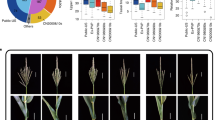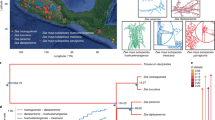Abstract
The success of modern maize breeding has been demonstrated by remarkable increases in productivity over the last four decades. However, the underlying genetic changes correlated with these gains remain largely unknown. We report here the sequencing of 278 temperate maize inbred lines from different stages of breeding history, including deep resequencing of 4 lines with known pedigree information. The results show that modern breeding has introduced highly dynamic genetic changes into the maize genome. Artificial selection has affected thousands of targets, including genes and non-genic regions, leading to a reduction in nucleotide diversity and an increase in the proportion of rare alleles. Genetic changes during breeding happen rapidly, with extensive variation (SNPs, indels and copy-number variants (CNVs)) occurring, even within identity-by-descent regions. Our genome-wide assessment of genetic changes during modern maize breeding provides new strategies as well as practical targets for future crop breeding and biotechnology.
This is a preview of subscription content, access via your institution
Access options
Subscribe to this journal
Receive 12 print issues and online access
$209.00 per year
only $17.42 per issue
Buy this article
- Purchase on Springer Link
- Instant access to full article PDF
Prices may be subject to local taxes which are calculated during checkout




Similar content being viewed by others
Change history
27 August 2014
In the version of this article initially published, Figure 2 and related results were flawed because of errors in the analysis that incorrectly assigned the B73 reference genotype to non–overlapping SNP sites, resulting in SNPs being inappropriately combined. In addition, the authors have revised identity–by–descent (IBD) region identification using a 50–SNP sliding window with a step size of 5 SNPs and excluded regions with genetic distance of ≤0.05 cM. As a result of these changes, the authors have provided a corrected version of the paper to be appended to the original publication (the Online Methods, Figs. 1–4 and their legends, and Table 1 and its legend were revised). Minor revisions have also been made in the main text to reflect changes to calculations resulting from the above corrections (changes are made in paragraphs 2 and 3 of original page 812, paragraphs 1 and 2 of original page 813, and paragraphs 1–6 of original page 814). In addition, corrected versions of Supplementary Tables 2–6 and 11 and Supplementary Figures 1, 2, 5 and 6, and two new supplementary figures and one new supplementary table have been added. The main conclusions of the paper were not affected by the corrections.
27 August 2014
Nat. Genet. 44, 812–815 (2012); published online 3 June 2012; corrected after print 27 August 2014 In the version of this article initially published, Figure 2 and related results were flawed because of errors in the analysis that incorrectly assigned the B73 reference genotype to non-overlapping SNP sites, resulting in SNPs being inappropriately combined.
References
Doebley, J. The genetics of maize evolution. Annu. Rev. Genet. 38, 37–59 (2004).
Duvick, D.N. The contribution of breeding to yield advances in maize (Zea mays L.). Adv. Agron. 86, 83–145 (2005).
Duvick, D.N. Commercial strategies for exploitation of heterosis. in The Genetics and Exploitation of Heterosis in Crops (eds. Coors, J.G. & Pandey, S.) 295–304 Misc: (ASA-CSSA-SSSA Publication, Madison, Wisconsin, 1999).
Liu, K. et al. Genetic structure and diversity among maize inbred lines as inferred from DNA microsatellites. Genetics 165, 2117–2128 (2003).
Gore, M.A. et al. A first-generation haplotype map of maize. Science 326, 1115–1117 (2009).
Lai, J. et al. Genome-wide patterns of genetic variation among elite maize inbred lines. Nat. Genet. 42, 1027–1030 (2010).
Grotewold, E., Athma, P. & Peterson, T. A possible hot spot for Ac insertion in the maize P gene. Mol. Gen. Genet. 230, 329–331 (1991).
Tian, F. et al. Genome-wide association study of leaf architecture in the maize nested association mapping population. Nat. Genet. 43, 159–162 (2011).
Scanlon, M.J., Stinard, P.S., James, M.G., Myers, A.M. & Robertson, D.S. Genetic analysis of 63 mutations affecting maize kernel development isolated from Mutator stocks. Genetics 136, 281–294 (1994).
Salvi, S. et al. Conserved noncoding genomic sequences associated with a flowering-time quantitative trait locus in maize. Proc. Natl. Acad. Sci. USA 104, 11376–11381 (2007).
Nielsen, R. et al. Genomic scans for selective sweeps using SNP data. Genome Res. 15, 1566–1575 (2005).
Yamasaki, M. et al. A large-scale screen for artificial selection in maize identifies candidate agronomic loci for domestication and crop improvement. Plant Cell 17, 2859–2872 (2005).
Wright, S.I. et al. The effects of artificial selection on the maize genome. Science 308, 1310–1314 (2005).
Pickrell, J.K. et al. Signals of recent positive selection in a worldwide sample of human populations. Genome Res. 19, 826–837 (2009).
Song, X.J., Huang, W., Shi, M., Zhu, M.Z. & Lin, H.X. A QTL for rice grain width and weight encodes a previously unknown RING-type E3 ubiquitin ligase. Nat. Genet. 39, 623–630 (2007).
Weng, J. et al. Isolation and initial characterization of GW5, a major QTL associated with rice grain width and weight. Cell Res. 18, 1199–1209 (2008).
Shomura, A. et al. Deletion in a gene associated with grain size increased yields during rice domestication. Nat. Genet. 40, 1023–1028 (2008).
Fan, C. et al. GS3, a major QTL for grain length and weight and minor QTL for grain width and thickness in rice, encodes a putative transmembrane protein. Theor. Appl. Genet. 112, 1164–1171 (2006).
Wang, E. et al. Control of rice grain-filling and yield by a gene with a potential signature of domestication. Nat. Genet. 40, 1370–1374 (2008).
Schnable, P.S. et al. The B73 maize genome: complexity, diversity, and dynamics. Science 326, 1112–1115 (2009).
Palmer, L.E. et al. Maize genome sequencing by methylation filtration. Science 302, 2115–2117 (2003).
Clark, R.M., Tavare, S. & Doebley, J. Estimating a nucleotide substitution rate for maize from polymorphism at a major domestication locus. Mol. Biol. Evol. 22, 2304–2312 (2005).
Roach, J.C. et al. Analysis of genetic inheritance in a family quartet by whole-genome sequencing. Science 328, 636–639 (2010).
Ossowski, S. et al. The rate and molecular spectrum of spontaneous mutations in Arabidopsis thaliana. Science 327, 92–94 (2010).
Denver, D.R. et al. A genome-wide view of Caenorhabditis elegans base-substitution mutation processes. Proc. Natl. Acad. Sci. USA 106, 16310–16314 (2009).
You, Y.H., Li, C. & Pfeifer, G.P. Involvement of 5-methylcytosine in sunlight-induced mutagenesis. J. Mol. Biol. 293, 493–503 (1999).
Itsara, A. et al. De novo rates and selection of large copy number variation. Genome Res. 20, 1469–1481 (2010).
Tian, Z. et al. Artificial selection for determinate growth habit in soybean. Proc. Natl. Acad. Sci. USA 107, 8563–8568 (2010).
Zheng, P. et al. A phenylalanine in DGAT is a key determinant of oil content and composition in maize. Nat. Genet. 40, 367–372 (2008).
Uauy, C., Distelfeld, A., Fahima, T., Blechl, A. & Dubcovsky, J. A NAC Gene regulating senescence improves grain protein, zinc, and iron content in wheat. Science 314, 1298–1301 (2006).
Poland, J.A., Bradbury, P.J., Buckler, E.S. & Nelson, R.J. Genome-wide nested association mapping of quantitative resistance to northern leaf blight in maize. Proc. Natl. Acad. Sci. USA 108, 6893–6898 (2011).
Kump, K.L. et al. Genome-wide association study of quantitative resistance to southern leaf blight in the maize nested association mapping population. Nat. Genet. 43, 163–168 (2011).
Tester, M. & Langridge, P. Breeding technologies to increase crop production in a changing world. Science 327, 818–822 (2010).
Moose, S.P. & Mumm, R.H. Molecular plant breeding as the foundation for 21st century crop improvement. Plant Physiol. 147, 969–977 (2008).
Li, H. & Durbin, R. Fast and accurate short read alignment with Burrows-Wheeler transform. Bioinformatics 25, 1754–1760 (2009).
Li, H. et al. The Sequence Alignment/Map format and SAMtools. Bioinformatics 25, 2078–2079 (2009).
McKenna, A. et al. The Genome Analysis Toolkit: a MapReduce framework for analyzing next-generation DNA sequencing data. Genome Res. 20, 1297–1303 (2010).
Yoon, S., Xuan, Z., Makarov, V., Ye, K. & Sebat, J. Sensitive and accurate detection of copy number variants using read depth of coverage. Genome Res. 19, 1586–1592 (2009).
Browning, B.L. & Browning, S.R. A unified approach to genotype imputation and haplotype-phase inference for large data sets of trios and unrelated individuals. Am. J. Hum. Genet. 84, 210–223 (2009).
Stephens, M. & Scheet, P. Accounting for decay of linkage disequilibrium in haplotype inference and missing-data imputation. Am. J. Hum. Genet. 76, 449–462 (2005).
Roberts, A. et al. Inferring missing genotypes in large SNP panels using fast nearest-neighbor searches over sliding windows. Bioinformatics 23, i401–i407 (2007).
Yang, J., Lee, S.H., Goddard, M.E. & Visscher, P.M. GCTA: a tool for genome-wide complex trait analysis. Am. J. Hum. Genet. 88, 76–82 (2011).
Zhang, Z. et al. Mixed linear model approach adapted for genome-wide association studies. Nat. Genet. 42, 355–360 (2010).
Schneeberger, K. et al. Reference-guided assembly of four diverse Arabidopsis thaliana genomes. Proc. Natl. Acad. Sci. USA 108, 10249–10254 (2011).
Huang, X. & Madan, A. CAP3: a DNA sequence assembly program. Genome Res. 9, 868–877 (1999).
Boetzer, M., Henkel, C.V., Jansen, H.J., Butler, D. & Pirovano, W. Scaffolding pre-assembled contigs using SSPACE. Bioinformatics 27, 578–579 (2011).
Felsenstein, J. PHYLIP: phylogeny inference package (version 3.2). Cladistics 5, 164–166 (1989).
Tajima, F. Evolutionary relationship of DNA sequences in finite populations. Genetics 105, 437–460 (1983).
Tajima, F. Statistical method for testing the neutral mutation hypothesis by DNA polymorphism. Genetics 123, 585–595 (1989).
Hudson, R.R., Boos, D.D. & Kaplan, N.L. A statistical test for detecting geographic subdivision. Mol. Biol. Evol. 9, 138–151 (1992).
Thornton, K. Libsequence: a C++ class library for evolutionary genetic analysis. Bioinformatics 19, 2325–2327 (2003).
Huang, X. et al. High-throughput genotyping by whole-genome resequencing. Genome Res. 19, 1068–1076 (2009).
Acknowledgements
We thank E.S. Buckler and J. Ross-Ibarra for helpful discussions, E.S. Buckler, T.R. Rocheford, M. Bohn and P. Becraft for assistance in making some of the Ex-PVP lines available and J. Dai, S. Wang and T. Wang for sharing Chinese germplasm. Research is supported by the National Basic Research Program (973 program) (2009CB118400).
Author information
Authors and Affiliations
Contributions
J.L. designed the project. J.L., Y.J. and H.Z. wrote the manuscript. Y.J., H.Z., L.R., B.Z. and S.X. performed most data analyses. W.S., J.G., B.W., Z.L., J.C., W.L. and M.Z. collected the inbred lines and prepared DNA samples for sequencing.
Corresponding author
Ethics declarations
Competing interests
The authors declare no competing financial interests.
Supplementary information
Supplementary Text and Figures
Supplementary Tables 1–4 and 6–11 and Supplementary Figures 1–8 (PDF 918 kb)
Supplementary Table 5
The list of selective regions and genes (XLSX 524 kb)
Supplementary Table 12
Three subgroups of the 278 inbred lines (XLSX 19 kb)
Rights and permissions
About this article
Cite this article
Jiao, Y., Zhao, H., Ren, L. et al. Genome-wide genetic changes during modern breeding of maize. Nat Genet 44, 812–815 (2012). https://doi.org/10.1038/ng.2312
Received:
Accepted:
Published:
Issue Date:
DOI: https://doi.org/10.1038/ng.2312
This article is cited by
-
A complete telomere-to-telomere assembly of the maize genome
Nature Genetics (2023)
-
Deploying QTL-seq rapid identification and separation of the major QTLs of tassel branch number for fine-mapping in advanced maize populations
Molecular Breeding (2023)
-
Laboratory and field evaluation of maize resistance to the two-spotted spider mite, Tetranychus urticae
Journal of Pest Science (2023)
-
Unveiling the characteristics of popcorn by genome re-sequencing and integrating the ESTs and proteome data
Cereal Research Communications (2023)
-
Genomic insights into historical improvement of heterotic groups during modern hybrid maize breeding
Nature Plants (2022)



